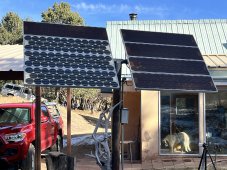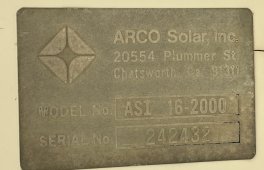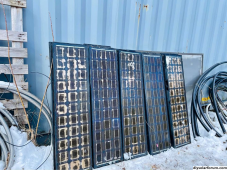peakbagger
Solar Enthusiast
- Joined
- Oct 26, 2021
- Messages
- 309
I have been interested in Solar since college reinforced by pouring over my brothers early black and white Home Power early editions. Over the years I saw them pop up on occasion in odd places like the local very much off grid Appalachian Mountain Club huts in the White Mountains of NH who used them to supply DC power for radios and very basically power. The biggest use i would see was the coast guard that installed large arrays at remote lighthouses to run the horns and lights. Pretty much the common panels I would see were the old ARCO 16-2000 33 watt panels and the later Siemens SR100s. I have been keeping an eye out for them for 10 plus years to have a piece of history as they were the first high volume produced panels I am aware of. Most were sold in CA but some made it to the Vermont to support the back to land movement. If you search on the web, this article (partially behind a paywall) got a lot of press. https://www.greenbuildingadvisor.com/article/testing-a-thirty-year-old-photovoltaic-module. my panels are the same panel.
The hassle with old panels is they cost a bundle to ship usually far more than the worth of the panel and some people think they must be made out of silver or are trying to get the original price they paid for them. I had located a slightly newer vintage panel a while back and the local UPS store near the buyer wanted about $100 to pack and ship one from Texas to NH and the seller would not break up the set. I was keeping an eye on Craigslist with not much luck until last week where there were three ARCO panels listed for $45. Two were 16-2000 and the third was an identical M61. The spec sheets on the back of the panels do not have much on them, no dates, no specs, just a logo, a model number and serial number. Arco sold out to Siemens in 1989 so they are at least 33 years old but were in production for several years after ARCO bought a small preceeding company in 1977.
The nickname I have heard of these are the "polka dot" panels. ARCO reportedly bought "seconds" of the single crystal wafers from the solar industry and maximized the output by not cutting the round wafers into squares. This made for a large panel but the wafers were the expensive part, so the layout optimized to maximize usage of the wafers.
So now I need to come up with a use for these. I am thinking of building up a cell phone charger using the cheap 12volt USB converters for cigarette lighter plugs in cars that used to be given away at tradeshows. It mostly to counter the standard BS out there that solar panels stop working and become hazardous waste after 20 years.
Worst case is I can put it where I store my working Solyndra presentation model and my early Solarex 10 watt amorphous panel
The hassle with old panels is they cost a bundle to ship usually far more than the worth of the panel and some people think they must be made out of silver or are trying to get the original price they paid for them. I had located a slightly newer vintage panel a while back and the local UPS store near the buyer wanted about $100 to pack and ship one from Texas to NH and the seller would not break up the set. I was keeping an eye on Craigslist with not much luck until last week where there were three ARCO panels listed for $45. Two were 16-2000 and the third was an identical M61. The spec sheets on the back of the panels do not have much on them, no dates, no specs, just a logo, a model number and serial number. Arco sold out to Siemens in 1989 so they are at least 33 years old but were in production for several years after ARCO bought a small preceeding company in 1977.
The nickname I have heard of these are the "polka dot" panels. ARCO reportedly bought "seconds" of the single crystal wafers from the solar industry and maximized the output by not cutting the round wafers into squares. This made for a large panel but the wafers were the expensive part, so the layout optimized to maximize usage of the wafers.
So now I need to come up with a use for these. I am thinking of building up a cell phone charger using the cheap 12volt USB converters for cigarette lighter plugs in cars that used to be given away at tradeshows. It mostly to counter the standard BS out there that solar panels stop working and become hazardous waste after 20 years.
Worst case is I can put it where I store my working Solyndra presentation model and my early Solarex 10 watt amorphous panel









![20230618_175138[1].jpg 20230618_175138[1].jpg](https://diysolarforum.com/data/attachments/153/153457-c2008a47daac47cc7b904f71819dec17.jpg)
